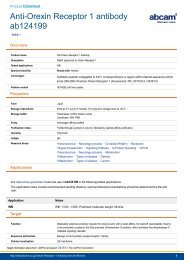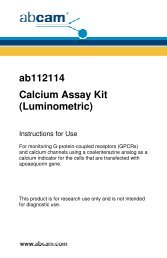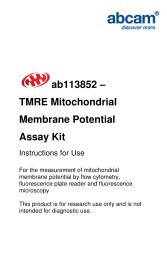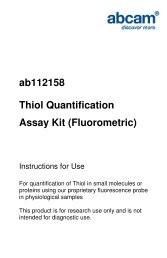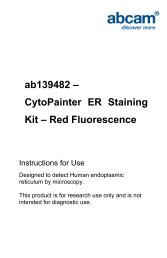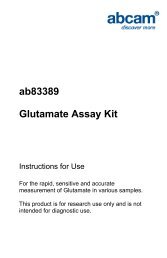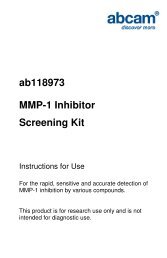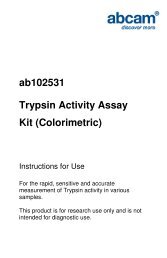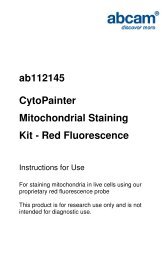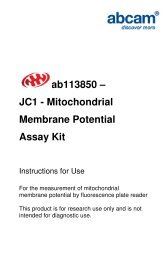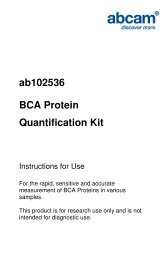ab105136 Myeloperoxidase Assay Kit (Colorimetric) - Abcam
ab105136 Myeloperoxidase Assay Kit (Colorimetric) - Abcam
ab105136 Myeloperoxidase Assay Kit (Colorimetric) - Abcam
You also want an ePaper? Increase the reach of your titles
YUMPU automatically turns print PDFs into web optimized ePapers that Google loves.
<strong>ab105136</strong><strong>Myeloperoxidase</strong><strong>Assay</strong> <strong>Kit</strong> (<strong>Colorimetric</strong>)Instructions for UseFor the rapid, sensitive and accuratemeasurement of <strong>Myeloperoxidase</strong> activity invarious samplesThis product is for research use only and is notintended for diagnostic use.Version: 4 Last Updated: 24 May 2013
Table of Contents1. Overview 32. Protocol Summary 43. Components and Storage 54. <strong>Assay</strong> Protocol 75. Data Analysis 96. Troubleshooting 112
1. Overview<strong>Myeloperoxidase</strong> (MPO) is a peroxidase enzyme (EC 1.11.1.7) mostabundantly expressed in neutrophil granulocytes. It is a lysosomalprotein stored in the azurophilic granules of the neutrophil. MPOcontains a heme pigment which causes its green color in secretionsrich in neutrophils, such as pus and some forms of mucus. MPOcatalyzes the production of hypochlorous acid (HClO) from hydrogenperoxide (H 2 O 2 ) and chloride anion (Cl - , or the equivalent from anon-chlorine halide). MPO also oxidizes tyrosine to a tyrosyl radicalusing hydrogen peroxide as an oxidizing agent.In <strong>Abcam</strong>’s <strong>Myeloperoxidase</strong> <strong>Assay</strong> <strong>Kit</strong>, the HClO produced fromH 2 O 2 and Cl - is reacted with taurine to generate the taurinechloramine, which subsequently reacts with the TNB2- probe toeliminate color (λ = 412 nm). The kit provides a rapid, simple,sensitive, and reliable test suitable for high throughput activity assayof MPO. This kit can be used to detect MPO as low as 0.05 mU perwell.3
2. Protocol SummarySample PreparationStandard Curve PreparationPrepare and Add Reaction MixMeasure Optical Density4
3. Components and StorageA. <strong>Kit</strong> ComponentsItemQuantityMPO <strong>Assay</strong> Buffer25 mLDNTB Probe (100mM)50 μLTCEP (50mM)50 μLMPO Substrate50 μLStop Mix (Lyophilized)20 μLMPO Positive Control (Lyophilized)1 vial* Store kit at -20°C, protect from light. Allow the <strong>Assay</strong> Buffer towarm up to room temperature before use. Briefly centrifuge all smallvials prior to opening. Read the entire protocol before performing theassay.TNB REAGENT/STANDARD: TNB is easily oxidizable so it needs tobe prepared from DTNB Probe as needed. Use the same day asprepared, discard any unused TNB reagent/standard. Take 0.5µlDTNB Probe for each well (standard, sample and backgroundcontrol) to be used. Add 0.5 µl TCEP and 49 µl <strong>Assay</strong> Buffer for a5
total of 50 µl per well. (Example: For 10 wells, take 5 µl DTNB Probe,5 µl TCEP and 490 µl Buffer, mix and set aside.)MPO SUBSTRATE: Aliquot and store at -20°C. Stable for 2 months.For working solution, add 5 µl MPO Substrate to 300 µl dH2O, mix.Aliquot and store at -20°C. The working solution is stable for oneweek.STOP MIX: Reconstitute with 220 μl dH 2 O. Aliquot and store at-20°C. Use within two months.MPO POSITIVE CONTROL: Reconstitute the positive control with100 μl MPO <strong>Assay</strong> Buffer. Aliquot and store at -20°C. Use within twomonths.B. Additional Materials RequiredMicrocentrifugePipettes and pipette tips<strong>Colorimetric</strong> microplate reader96 well plateOrbital shakerdH 2 O6
4. <strong>Assay</strong> Protocol1. Sample Preparation:Tissues or cells can be homogenized in 4 volumes of MPO <strong>Assay</strong>Buffer, centrifuged (13,000g, 10 min) to remove insolublematerial. Serum samples can be directly diluted in the MPO<strong>Assay</strong> Buffer.Add 1-50 µl test samples in 96 well plate & 5 - 10 µl of thereconstituted MPO Positive Control to the Positive Control well(s)(optional). Prepare parallel sample well(s) as background control.Adjust the final volume of sample, Positive Control & samplebackground control wells to 50 µl/well with MPO <strong>Assay</strong> Buffer.We suggest testing several doses of a sample to ensure thereadings are within the standard curve range.2. Standard Curve Preparation:Add 150, 140, 130, 120, 110 and 100 µl of MPO <strong>Assay</strong> Buffer into aseries of wells. The Standard will be added to the wells (0, 10, 20,30, 40, 50 µl respectively) at the end of the sample incubation period(see step 3 below).7
3. Reaction Mix Preparation:Mix enough reagents for the number of assays to be performed. Foreach well, prepare a Reaction Mix (50 µL) containing:MPO Measurement Background Control MixMPO <strong>Assay</strong> Buffer 40 µL 40 µLMPO Substrate 10 µL ---dH 2 O --- 10 µLAdd 50 μl of the Reaction Mix to each well containing the PositiveControls and Samples. Add 50 μl of the Sample Background ControlMix to the sample background controls. Mix well. Incubate at roomtemperature for 30 min to 2 hr (record this time as T), then add 2 μlStop Mix and mix well. Incubate another 10 min to stop the reactionthen add 50 μl TNB Reagent/Standard to each of the sample,sample background control & Positive Control wells. Add 0-10-20-30-40-50 µl TNB (0-10-20-30-40-50 nmol respectively) to theStandard wells at this time. Mix well.Note:It is suggested to run samples for 30 min, 1 hr and 2 hr, followed bythe Stop Mix and TNB Reagent additions at each time point-toensure values will fall within the linear range of the Standard Curve.(DO NOT ADD REACTION MIX OR STOP MIX TO STANDARDS)8
V is the pre-adjusted sample volume (ml) added into the reactionwell.One unit of MPO is defined as the amount of MPO which hydrolyzesthe substrate and generates taurine chloramine to consume1.0 μmol of TNB per minute at 25°C.10
6. TroubleshootingProblem Reason Solution<strong>Assay</strong> notworkingUnexpectedresults<strong>Assay</strong> buffer atwrong temperatureProtocol step missedPlate read atincorrect wavelengthUnsuitable microtiterplate for assayMeasured at wrongwavelengthSamples containimpeding substancesUnsuitable sampletypeSample readings areoutside linear range<strong>Assay</strong> buffer must not be chilled- needs to be at RTRe-read and follow the protocolexactlyEnsure you are usingappropriate reader and filtersettings (refer to datasheet)Fluorescence: Black plates(clear bottoms);Luminescence: White plates;Colorimetry: Clear plates.If critical, datasheet will indicatewhether to use flat- or U-shapedwellsUse appropriate reader and filtersettings described in datasheetTroubleshoot and also considerdeproteinizing samplesUse recommended samplestypes as listed on the datasheetConcentrate/ dilute samples tobe in linear range12
SampleswithinconsistentreadingsLower/Higherreadings insamplesandstandardsUnsuitable sampletypeSamples prepared inthe wrong bufferSamples notdeproteinized (ifindicated ondatasheet)Cell/ tissue samplesnot sufficientlyhomogenizedToo many freezethawcyclesSamples containimpeding substancesSamples are too oldor incorrectly storedNot fully thawed kitcomponentsOut-of-date kit orincorrectly storedreagentsReagents sitting forextended periods oniceIncorrect incubationtime/ temperatureIncorrect amountsusedRefer to datasheet for detailsabout incompatible samplesUse the assay buffer provided(or refer to datasheet forinstructions)Use the 10kDa spin column(ab93349)Increase sonication time/number of strokes with theDounce homogenizerAliquot samples to reduce thenumber of freeze-thaw cyclesTroubleshoot and also considerdeproteinizing samplesUse freshly made samples andstore at recommendedtemperature until useWait for components to thawcompletely and gently mix prioruseAlways check expiry date andstore kit components asrecommended on the datasheetTry to prepare a fresh reactionmix prior to each useRefer to datasheet forrecommended incubation timeand/ or temperatureCheck pipette is calibratedcorrectly (always use smallestvolume pipette that can pipetteentire volume)13
Problem Reason SolutionStandardcurve is notlinearNot fully thawed kitcomponentsPipetting errors whensetting up thestandard curveIncorrect pipettingwhen preparing thereaction mixAir bubbles in wellsConcentration ofstandard stockincorrectErrors in standardcurve calculationsUse of otherreagents than thoseprovided with the kitWait for components to thawcompletely and gently mix prioruseTry not to pipette too smallvolumesAlways prepare a master mixAir bubbles will interfere withreadings; try to avoid producingair bubbles and always removebubbles prior to reading platesRecheck datasheet forrecommended concentrations ofstandard stocksRefer to datasheet and re-checkthe calculationsUse fresh components from thesame kitFor further technical questions please do not hesitate tocontact us by email (technical@abcam.com) or phone (select“contact us” on www.abcam.com for the phone number foryour region).14
UK, EU and ROWEmail: technical@abcam.com | Tel: +44-(0)1223-696000AustriaEmail: wissenschaftlicherdienst@abcam.com | Tel: 019-288-259FranceEmail: supportscientifique@abcam.com | Tel: 01-46-94-62-96GermanyEmail: wissenschaftlicherdienst@abcam.com | Tel: 030-896-779-154SpainEmail: soportecientifico@abcam.com | Tel: 911-146-554SwitzerlandEmail: technical@abcam.comTel (Deutsch): 0435-016-424 | Tel (Français): 0615-000-530US and Latin AmericaEmail: us.technical@abcam.com | Tel: 888-77-ABCAM (22226)CanadaEmail: ca.technical@abcam.com | Tel: 877-749-8807China and Asia PacificEmail: hk.technical@abcam.com | Tel: 108008523689 ( 中 國 聯 通 )JapanEmail: technical@abcam.co.jp | Tel: +81-(0)3-6231-0940www.abcam.com | www.abcam.cn | www.abcam.co.jpVersion: 4 Last Updated: 24 May 2013Copyright Copyright © 2012 2013 <strong>Abcam</strong>, <strong>Abcam</strong>, All All Rights Rights Reserved. Reserved. The The <strong>Abcam</strong> <strong>Abcam</strong> logo logo is is a registered registered trademark. trademark.All All information information / detail detail is is correct correct at at time time of of going going to to print. print.



